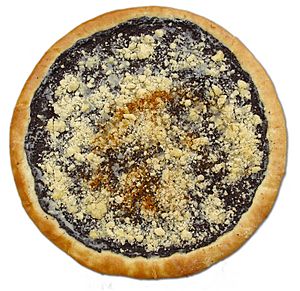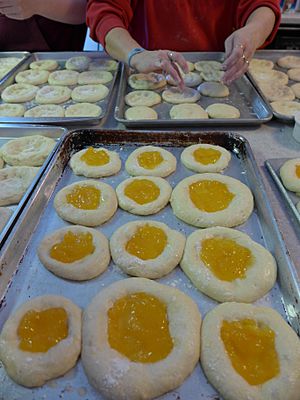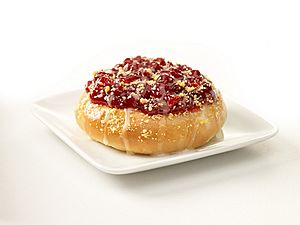Kolach (cake) facts for kids

Larger koláč, called "frgál", typical of the Moravian Wallachia area
|
|
| Type | Sweet bread |
|---|---|
| Place of origin | Czech lands and Slovakia |
| Region or state | Central Europe |
A kolach (also spelled kolache, kolace or kolacky /kəˈlɑːtʃi, -tʃki/, from the Czech and Slovak plural koláče, sg. koláč, diminutive koláčky, meaning "cake/pie") is a type of sweet pastry that holds a portion of fruit surrounded by puffy dough. It is made from yeast dough and common flavors include Quark, a dairy product, tvaroh spread, fruit jam and poppy seeds mixed with powidl (povidla).
Originating as a semisweet pastry from Central Europe, they have also become popular in parts of the United States, particularly in the state of Texas. The name originates from the Czech (Bohemian), and originally Old Slavonic word kolo meaning "circle", "wheel".
In some parts of the US, klobásník, which contains sausage or other meat, is also called kolach because the same dough is used. Unlike kolache, which came to the United States with Czech immigrants, klobásníky were first made by Czechs who settled in Texas. In contrast, Czech koláč is always sweet.
Kolaches are often associated with Cedar Rapids and Pocahontas in Iowa where they were introduced by Czech immigrants in the 1870s. They are served at church suppers and on holidays but also as an everyday comfort food. Recipes are usually passed down with some including spices like mace or nutmeg. They can be filled with a combination of prune, apricot, cream cheese, poppy seed or assorted other fillings.
Kolache celebrations
Bujanov holds annual kolache celebrations (Koláčové slavnosti) and kolache marathon (Koláčové běhy).
Several US cities, including Tabor, South Dakota; Verdigre, Nebraska; Wilber, Nebraska; Prague, Nebraska; Caldwell, Texas; New Prague, Minnesota; East Bernard, Texas; Crosby, Texas; Hallettsville, Texas; Prague, Oklahoma; St. Ludmila's Catholic Church in Cedar Rapids, Iowa; and Kewaunee, Wisconsin hold annual Kolache Festival celebrations.
Both Verdigre, Nebraska, and Montgomery, Minnesota, claim to be the "Kolacky capital of the world". Prague, Nebraska, claims to be known as the home of the world's largest kolache. Both Caldwell, Texas, and West, Texas, claim the title of "Kolache Capital" of the state and kolaches are extremely popular in Central and Eastern Texas. There is even a Texas Czech Belt which grew in the 1880s and is full of kolache bakeries.
Haugen, Wisconsin, is the Kolache Capital of Wisconsin. The village is a Bohemian settlement that celebrates its Czech Heritage during an annual festival (Haugen Fun Days). Kolaches are a staple of the village's festival with Kolache sales, bake-offs, and tastings. Kolache may be found at Czech-American festivals in other communities in the United States.
It was the sweet chosen to represent the Czech Republic in the Café Europe initiative of the Austrian presidency of the European Union, on Europe Day 2007.
Many people in the United States refer to the sausage-filled Czech pastries as kolaches, but these are klobasniky which were invented by Czech immigrants in Texas.
Related dishes
A related dish is a klobasnek, which is popular in central and southeast Texas, specifically Houston. It often uses similar bread but is filled with a link of sausage or ground sausage. Some people also refer to these as kolache, but they are more closely related to a "pig in a blanket". They may also contain ham, cheese, jalapeño, eggs and bacon/sausage, potato, etc., and resemble a "pig in a blanket". Czech settlers created klobasniky after they immigrated to Texas.
mk:Колач
See also
 In Spanish: Kolache para niños
In Spanish: Kolache para niños





